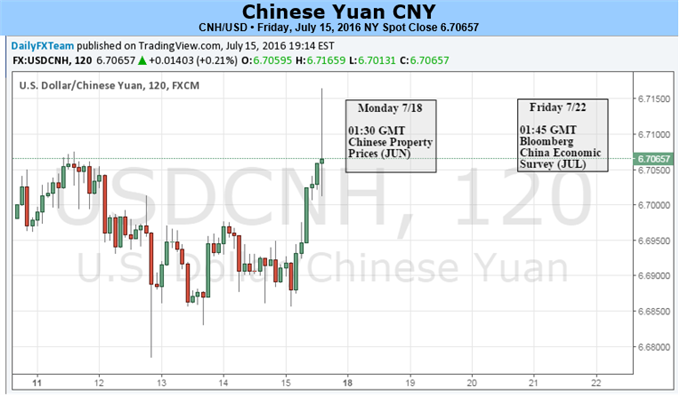
Fundamental Forecast for the Yuan: Neutral
- China’s Market News: Yuan at Key Resistance Ahead of 2Q GDP
- China’s Market News:Yuan Borrowing Rate Soars in Offshore Market
- What Are the Traits of Successful Traders?
Both onshore and offshore Yuan retraced against the US Dollar this week: the onshore Yuan (USD/CNY) closed at a slightly more bullish position, at 6.6810 following four consecutive drops on a weekly basis; the offshore Yuan (USD/CNH) touched 6.7076 on Monday and then pulled back after Yuan liquidity was tightened in the offshore market. Both Dollar/Yuan pairs moved below key resistance levels of 6.70. At the same time, the British Pound which is included in the Yuan currency basket, recovered early losses and gained against the Chinese Yuan on the week. The onshore Yuan (GBP/CNY) dropped -2.46% while the offshore Yuan (GBP/CNH) fell -2.63%. This put less pressure on the PBoC to strategically devalue against the US Dollar in the effort of evening-out gains in the Yuan currency basket. Looking into next week, 6.70 will continue to be a key level for both USD/CNY and USD/CNH. From China’s side, the PBOC has been tightening onshore liquidity and is less likely to introduce aggressive easing programs in the near-future. In terms of outside of China, event risk from European Central Bank and US economic data may lead to major breakouts in Yuan rates.
While the Bank of England and Bank of Japan have put further easing programs on their agenda, China’s Central Bank adopts a moderate monetary policy and is likely to continue over the following periods. The PBOC has been tightening short-term liquidity over the past two weeks by reducing the issuance of 7-day reverse repos. In terms of medium-term liquidity, the Central Bank has withdrawn cash in the broader scope but injected liquidity into target financial institutions. The benchmark rates for Yuan, SHIBOR O/N, 1W, 1M and 3M, are all in a downtrend beginning on June 28. These moves highly reduced the odds of the PBOC to cut rate in the near future. This will leave less downward pressure on the Chinese Yuan.
Under China’s current economic situation, introducing more stimulus may not help the economy much. The most recent New Yuan Loans show that bank credit issued in the first half of 2016 was 7.53 trillion Yuan, increasing 967.1 billion Yuan from its 2015 read. However, the growth in private investment in the first six months dropped sharply to 2.8% from 11.4% a year ago. Private investment is one of the most important leading indicators to evaluate China’s economy as it has accounted for approximate 60% of China’s GDP and contributed to 80% of overall employment. The low private investment and high Yuan loans indicate that A) private sectors lack investment opportunities, and this is bad news for the economy, and B) those loans are not being made to private investment. In fact, the breakdown of the New Yuan Loans shows that 2.95 trillion Yuan of loans went to the real estate sector over the first half year. Thanks to soaring home prices in tier-one and tier-two cities, Chinese banks have issued a huge amount of mortgages to households. They prefer to lend to home purchasers who have lower risk rather than to companies looking to develop business in a slowing economy. Thus, even if the Central Bank introduces more stimulus, banks may still have less incentive to lend to businesses as was seen in January; and companies may still have less incentive to borrow to expand their business. Most likely, liquidity will flow into the housing sector and increase the risk of price bubbles even more.
External factors, on the other hand, could drive large moves in Yuan rates next week. European Central Bank (ECB) will announce its benchmark rate decision on July 21 and host a press conference following the release. A rate cut or an outlook on further easing programs could bring down the Euro, which is included in the Yuan currency basket. In order to maintain the Yuan’s relative stability to the currency basket, the Dollar/Yuan pair may need to move in the opposite direction. Still, 6.70 is a major level that the PBOC has been watching. The offshore USD/CNH fell below 6.70 on Tuesday following the sudden increase in Yuan borrowing costs. Traders will want to keep a close eye on Yuan’s daily fixing. A fixing above 6.70 is a signal that the PBOC agrees with Yuan breakout and moving further lower against the Dollar. In addition to PBOC’s guidance, event risks including US Jobless Claims, Home Sales, as well as Republican National Convention could directly affect Dollar/Yuan pairs as well.






